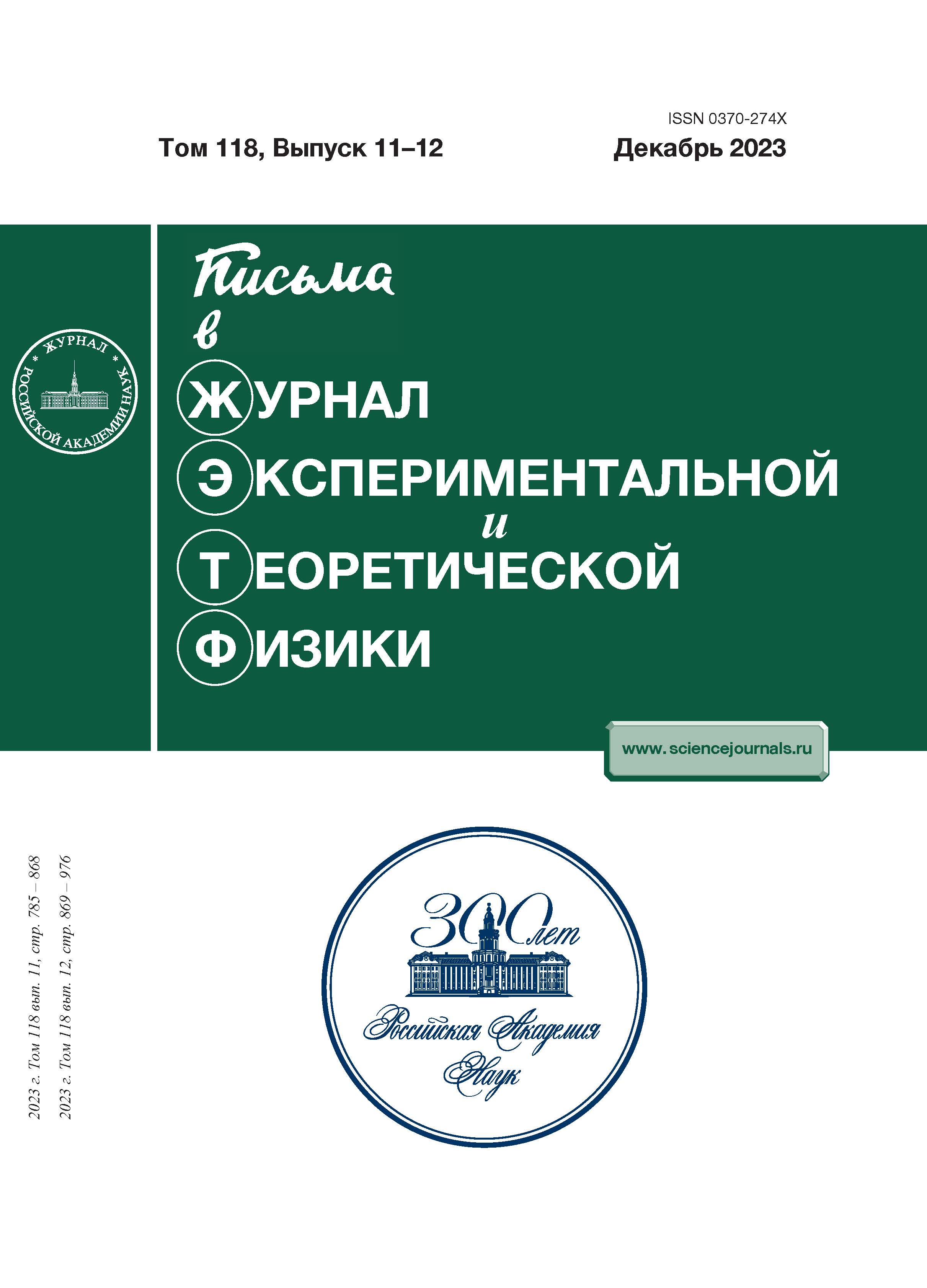Magnon Topological Transition in Skyrmion Crystal
- Autores: Timofeev V.E.1,2, Baramygina Y.V.1,2, Aristov D.N.1,2
-
Afiliações:
- Petersburg Nuclear Physics Institute, National Research Center Kurchatov Institute
- St. Petersburg State University
- Edição: Volume 118, Nº 11-12 (12) (2023)
- Páginas: 908-914
- Seção: Articles
- URL: https://archivog.com/0370-274X/article/view/664211
- DOI: https://doi.org/10.31857/S1234567823240072
- EDN: https://elibrary.ru/NLXBTN
- ID: 664211
Citar
Texto integral
Resumo
We study the magnon spectrum in skyrmion crystal formed in thin ferromagnetic films with Dzyaloshinskii–Moriya interaction in presence of magnetic field. Focusing on two low-lying observable magnon modes and employing stereographic projection method, we develop a theory demonstrating a topological transition in the spectrum. Upon the increase in magnetic field, the gap between two magnon bands closes, with the ensuing change in the topological character of both bands. This phenomenon of gap closing, if confirmed in magnetic resonance experiments, may deserve further investigation by thermal Hall conductivity experiments.
Sobre autores
V. Timofeev
Petersburg Nuclear Physics Institute, National Research Center Kurchatov Institute;St. Petersburg State University
Email: victor.timofeev@thd.pnpi.spb.ru
188300, Gatchina, Russia;199034, St. Petersburg, Russia
Yu. Baramygina
Petersburg Nuclear Physics Institute, National Research Center Kurchatov Institute;St. Petersburg State University
Email: victor.timofeev@thd.pnpi.spb.ru
188300, Gatchina, Russia;199034, St. Petersburg, Russia
D. Aristov
Petersburg Nuclear Physics Institute, National Research Center Kurchatov Institute;St. Petersburg State University
Autor responsável pela correspondência
Email: victor.timofeev@thd.pnpi.spb.ru
188300, Gatchina, Russia;199034, St. Petersburg, Russia
Bibliografia
- H. Vakili, J.-W. Xu, W. Zhou, M. N. Sakib, M. G. Morshed, T. Hartnett, Y. Quessab, K. Litzius, C. T. Ma, S. Ganguly, M. R. Stan, P. V. Balachandran, G. S. D. Beach, S. J. Poon, A. D. Kent, and A. W. Ghosh, J. Appl. Phys. 130, 070908 (2021).
- M.-K. Lee and M. Mochizuki, Phys. Rev. Appl. 18, 014074 (2022).
- A. Fert, N. Reyren, and V. Cros, Nat. Rev. Mater. 2, 1 (2017).
- K. Everschor-Sitte, J. Masell, R. M. Reeve, and M. Kl¨aui, J. Appl. Phys. 124, 240901 (2018).
- N. Nagaosa and Y. Tokura, Nature Nanotech. 8, 899 (2013).
- M. Garst, J. Waizner, and D. Grundler, J. Phys. D: Appl. Phys. 50, 293002 (2017).
- A. A. Belavin and A. M. Polyakov, JETP Lett. 22, 245 (1975).
- A. N. Bogdanov and D. Yablonskii, ZhETF 95, 178 (1989).
- A. Bogdanov and A. Hubert, J. Magn. Magn. Mater. 138, 255 (1994).
- S. Mu¨hlbauer, B. Binz, F. Jonietz, C. P eiderer, A. Rosch, A. Neubauer, R. Georgii, and P. B¨oni, Science 323, 915 (2009).
- C. Schu¨tte and M. Garst, Phys. Rev. B 90, 094423 (2014).
- S.-Z. Lin, C. D. Batista, and A. Saxena, Phys. Rev. B 89, 024415 (2014).
- A. Rold'an-Molina, A. S. Nunez, and J. Fern'andez-Rossier, New J. Phys. 18, 045015 (2016).
- V. E. Timofeev and D. N. Aristov, Phys. Rev. B 105, 024422 (2022).
- O. Petrova and O. Tchernyshyov, Phys. Rev. B 84, 214433 (2011).
- V. E. Timofeev and D. N. Aristov, JETP Lett. 118, 455 (2023).
- S. A. D'ıaz, T. Hirosawa, J. Klinovaja, and D. Loss, Physical Review Research 2, 013231 (2020).
- K. Mæland and A. Sudbø, Phys. Rev. Res. 4, L032025 (2022).
- K. A. van Hoogdalem, Y. Tserkovnyak, and D. Loss, Phys. Rev. B 87, 024402 (2013).
- R. Matsumoto, R. Shindou, and S. Murakami, Phys. Rev. B 89, 054420 (2014).
- W. D¨oring, Z. Naturforsch. A 3, 373 (1948).
- V. E. Timofeev, A. O. Sorokin, and D. N. Aristov, JETP Lett. 109, 207 (2019).
- V. E. Timofeev, A. O. Sorokin, and D. N. Aristov, Phys. Rev. B 103, 094402 (2021).
- V. E. Timofeev and D. N. Aristov, JETP Lett. 117, 676 (2023).
Arquivos suplementares










